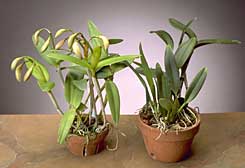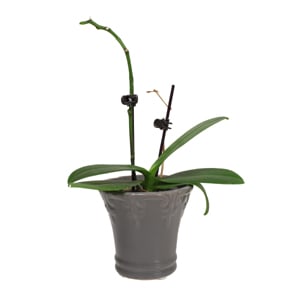
The nighttime temperature being too high is a common cause of orchids not blooming. For an orchid to produce a new flower spike and to begin flowering, the temperature at night needs to be 10°F lower than the daytime temperature. Orchids cannot bloom if there is no difference in temperature between day and night.
Reasons why orchids don’t bloom include:
- For orchids to begin flowering, the nighttime temperature must be lower.
- Light is insufficient to encourage blooming.
- To encourage the growth of additional spikes and more blooms, flower spikes should be pruned.
- the absence of fertilizer
- Low humidity and drought stress inhibit flowering.
- The incorrect planting material and overwatering cause stress on orchids and stop them from flowering.
- In order to flower, orchids need a period of rest in the winter.
One of the most effective ways to encourage blooms is to make sure the orchid has a temperature that is 10°F lower at night than it does during the day.
Continue reading to learn the causes of your orchid’s failure to bloom and how to fix them so they do so more frequently.
Table of Contents
1. Orchids Require a Cooler Temperature at Night to Stimulate Flowering
Orchids are specialized to growing in a certain temperature range, with average daytime temperatures of 66°F to 75°F (19°C to 23°C) and nighttime temperatures of 61°F to 66°F (16°C to 19°C). Phalaenopsis, or moth orchids, can withstand daytime highs of 86°F (30°C).
The orchid is stimulated to produce a new flower spike and bloom by the difference in temperature between a chilly night and a warmer day.
The orchid can grow and produce flowers even when there is no difference in temperature between day and night.
This can be particularly troublesome in modern homes because heating systems frequently cause dwellings to warm up in the evening rather than cool down, which is contrary to the natural environment of orchids.
The answer is…
Place the orchid in a cool spot in the evening that is normally between 55°F and 66°F (12°C and 19°C) or 5°F cooler than the typical day temperature, such as a window sill or porch, to encourage flowering. This will mimic the temperature variation between day and night in the home.
Keep any heat sources away from the orchid.
It is crucial to remember that the orchid can adapt to a variety of temperature ranges and can typically endure lows of 55°F (12°C) at night and highs of 75°F (23°C) during the day.
For 2-4 weeks, aim for a nighttime temperature difference of about 10°F (5°C) cooler to encourage the growth of additional blooms and flower spikes.
A fresh flower spike should appear after a few weeks of milder nighttime temperatures, indicating that the orchid can begin to bloom once more.
Moth orchids can be cultivated to flower at any time of the year by commercial orchid growers who supply garden centers. They all expose their orchids to cooler nighttime temperatures in nurseries to encourage the growth of a new flower spike so that the orchid can be in flower and look its best when it is sold.
2. Not Enough Light for Flowering
The most popular indoor orchids, Phalaenopsis, often called moth orchids, are found in tropical woods in Asia where they thrive in filtered or direct sunlight.
Orchids flower longer and more frequently in bright rooms of a house when these circumstances are present. The orchid lacks the energy to drive bloom creation if it is kept in a very dark, low-light area of your home.
The Approach…
In order to encourage flowering in orchids, it is crucial to mimic the light conditions found in their natural habitat.
Avoid placing orchids in rooms with North-facing windows, as they may still be able to bloom there, but they are less likely to do so repeatedly or to their fullest extent.
While some filtered light can be tolerated (especially in northern latitudes like New York, the Pacific North West, or the UK where the sun is less intense), it is crucial to avoid prolonged exposure to direct sunlight because orchid leaves are delicate and can scorch yellow or brown if exposed to too much sunlight.
This may also stress the plant, resulting in the loss of current blossoms or a failure to flower for the orchid.
The orchid will have all the energy and resources needed to produce flowers if you place it in a good, bright area that mimics its preferred natural surroundings.
3. Cut back Spent Flower Spikes to Stimulate Flowering
Once an orchid has bloomed on a flower spike, it typically stops blooming on any nodes that have previously flowered on the same spike.
Accordingly, if the orchid has already flowered and the flowers have fallen off, you may wind up with a long, green flower spike that is devoid of blooms and unlikely to produce any more.
Sometimes the flower spike becomes partially or completely brown or yellow all the way back to the plant’s base, in which case it is unable to develop new side shoots or additional blooms.
The Approach…
Although the rest of the orchid still appears green and healthy, this does not necessarily mean the orchid is dying. Nevertheless, you should trim back any flower spikes that are becoming brown or yellow to the plant’s root system.
A new flower spike with the ability to produce more blossoms should grow as a result of this.
Cut the flower spikes at approximately a half-inch (2 cm) above a node or developing branch if they are still green but not blossoming.
From an existing flower spike that has the ability to produce flowers, orchids frequently sprout a new stalk.
Orchids frequently require a drop in temperature throughout the night of about 10°F (5°C) for 2-4 weeks in order to promote the formation of new flower spikes.
This encourages the development of a fresh flower spike and informs the orchid that the time is appropriate to bloom.
Watch this informative YouTube video for all the information you require if you are confused of where or how to cut the flower spike:
4. Not Enough Fertilizer Prevents Flowering

When an orchid sits in the same container for too long, it can frequently exhaust the nutrients in the potting medium, which prevents it from producing more flower spikes or showing off its blossoms.
It is also challenging to mimic the orchids’ natural method of obtaining nutrients from the air in an indoor environment.
The Approach…
Therefore, it is crucial to apply a specialist orchid fertilizer that comes in a spray form, administered to the ariel roots and the potting medium, to ensure that orchids have all the readily available nutrients they need for flowering.
Utilizing a customized solution that has all the nutrients an orchid needs at the correct concentration to produce blooms is crucial.
Use a customized fertilizer and apply it every four weeks in the spring and summer to increase flowering as orchids with fertilizer frequently do not flower well. Ordinary houseplant fertilizer is likely to burn the roots.
5. Drought Stress and Low Humidity can Stop Blooming
The majority of orchid houseplants (Phalaenopsis) are tropical plants that thrive in climates with greater humidity levels and regular rainfall (although they can also grow in relatively well-draining circumstances).
While orchids normally demand a humidity of approximately 50%, the humidity in our houses is typically around 10%.
Due to the variation in humidity, the orchid either loses its blossoms or becomes too stressed to produce new flowers as a result of excessive water loss from the leaves and shriveling roots.
Low humidity levels in our houses are frequently made worse by:
- airflows brought on by forced air, air conditioning, or central heating.
- drafts coming from open windows.
- excessive sunshine
The Approach…
Because bathrooms frequently have humidity levels that are close to those in their natural forest habitat, orchids often thrive better and may even flower more when kept there.
However, by spraying the leaves, roots, and flower stems once a day or so, you may effectively cultivate and reproduce the ideal circumstances for orchids to flower in any room of the house.
By spraying the orchids, you can create a humid microclimate that mimics their native tropical environment and lessens water loss from the leaves.
If you are in an area that is very arid, I advise buying a plant humidifier from your neighborhood garden center (or Amazon) that will allow you to precisely manage the humidity level around your orchid so that it has all the resources and circumstances it needs to flower.
(To learn more about how low humidity affects orchids, see my post on how to resuscitate a withering orchid.)
6. Overwatering and Saturated Soil Mediums Prevents Blooming
Overwatering an orchid is one of the most frequent blunders made when taking care of them.
However, because they are epiphytic and grow on other trees, which means they are adapted to growing circumstances with adequate drainage, ventilation, and high humidity around the roots, while most houseplant orchids grow in situations with somewhat frequent rainfall.
The roots of the orchid can rot if it is irrigated excessively and its potting soil is kept continually moist.
The orchid is under stress because the withering roots are unable to gather and move the nutrients and moisture around the plant that are needed for blossoming. If the roots are shriveling, dying, or decaying, see my post on how to resuscitate a dying orchid.
The orchid plant will not produce flowers if the roots are unhealthy.
The Approach…
It’s crucial to plant orchids in the proper potting medium, which for Moth orchids (pahalenopsis) is a pine bark-based potting medium since it closely resembles the circumstances of their native environment, has excellent drainage, and allows humid air to circulate around the roots.
This ensures strong roots and greatly reduces the risk of overwatering thanks to the good drainage, allowing your orchid to bloom.
In order to keep the orchid healthy so that it can flower, water it every 7–10 days in the spring and summer (when the orchid is more likely to flower) and once every 10 days or so in the winter.
Only if you frequently repot them will moss-based potting mediums work well for growing orchids. Because they degrade more quickly than bark-based mediums, they tend to retain more moisture and have less oxygen available around the roots.
When this happens, an orchid may start to die (see my article, Why is my orchid dying?).
If an orchid has experienced any stress, it is likely to focus its energy on regrowth to replace any roots that may have died off in order to survive the bad conditions; in this scenario, it may take up to a year of good conditions for the orchid to begin to bloom once more.
(Read my post on how to water orchids to find out how frequently you should water orchids in various situations and seasons.)
7. Orchids Need a Rest Period in Winter to Display Flowers
Some orchids prefer to relax during the winter months when the temperature drops and they need less water and no fertilizer because of the diminished light.
This is so that when an orchid is exposed to more light and warmer temperatures in the spring, it has the resources and energy necessary to naturally flower. This is because some orchid species, like Dendrobium, experience a cycle of temperatures throughout the year in their native environment.
As evaporation levels and vegetative development are reduced during the Winter because of the shorter day lengths, orchids of all species should be watered less frequently at around once every 10 days. Fertilizer should also be avoided during this time.
The orchid should be able to display more blossoms in the spring when the watering is increased to once every seven days and an orchid-specific fertilizer is used.
